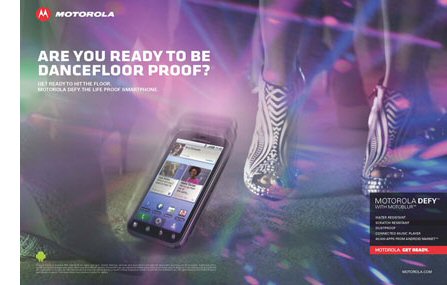The rugged mobile phone has traditionally been a niche product aimed at a small number of people for whom a durable device is essential. Sonim’s perhaps the best-known handset manufacturer in this area, but there are others — Samsung’s Xcover 271 and B2100 Xplorer spring to mind.
However, recent launches suggest that a growing number of phone-makers are trying to bring tough features to mass-market smartphones. This month sees the release of the Motorola Defy: the company’s latest Android product and perhaps soon to be better recognised as the first “rugged smartphone”.
Of course, Motorola’s Defy isn’t actually the first smartphone to offer toughened qualities. Others, such as Nokia’s N8, Apple’s iPhone 4 and the Samsung Galaxy S, share some of the Defy’s features, most notably Gorilla glass. This is a protective material, usually incorporated into capacitive touch-screen devices, that manufacturer Corning claims offers increased resistance to scratches and cracks.
Depending on your definition of rugged, Gorilla glass alone may not meet your demands. And this is where Motorola’s tried to set the Defy apart. It features IP67 certification, making it resistant to dust, water and shock. Motorola says the device can be submerged in a metre of water for up to 30 minutes and still work properly. This puts its performance closer to specialised products like Sonim’s.
Looking at high-street promotions for the device, it’s clear that Motorola’s pushing the Defy’s hardware strengths heavily, rather than focusing on the operating system and applications, as with other Android-powered devices. I’m not surprised by this move away from services; manufacturers will be looking to differentiate their products from other similar releases, particularly among the recent surge of Android devices.
My initial reaction to the Defy was slight scepticism. If I had such a high-end device, I’d certainly be a lot more cautious than usual and try hard not to dunk it in water or drop it on the street. So what’s the point of adding rugged qualities that only add to production costs? After all, surely all smartphone owners take care of their devices, don’t they?
But accidents do happen and smartphones are no different. I’ve seen many, many iPhones with cracked screens. A recent study by SquareTrade estimated that 14 percent of iPhone 4 devices suffer some form of accident damage.
This is where the Defy could really do well. It combines rugged features with the benefits of a smartphone, all packaged in a design that owes more to a catwalk than a building site. If Motorola pitches its marketing correctly, it could spark a whole new segment of the market.


 Twitter
Twitter
 Facebook
Facebook
 LinkedIn
LinkedIn
 Email
Email